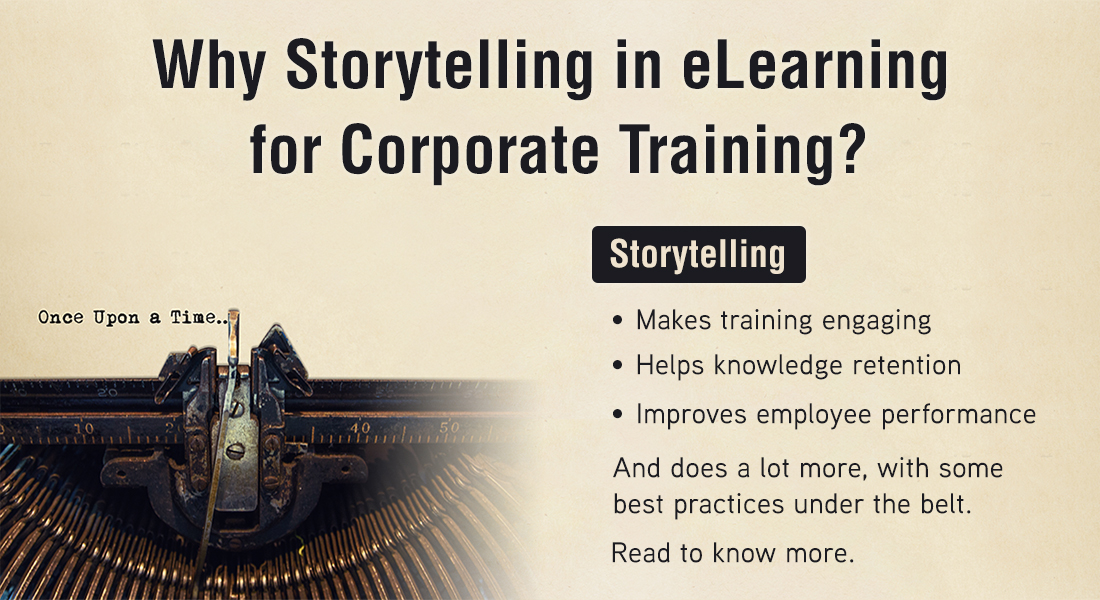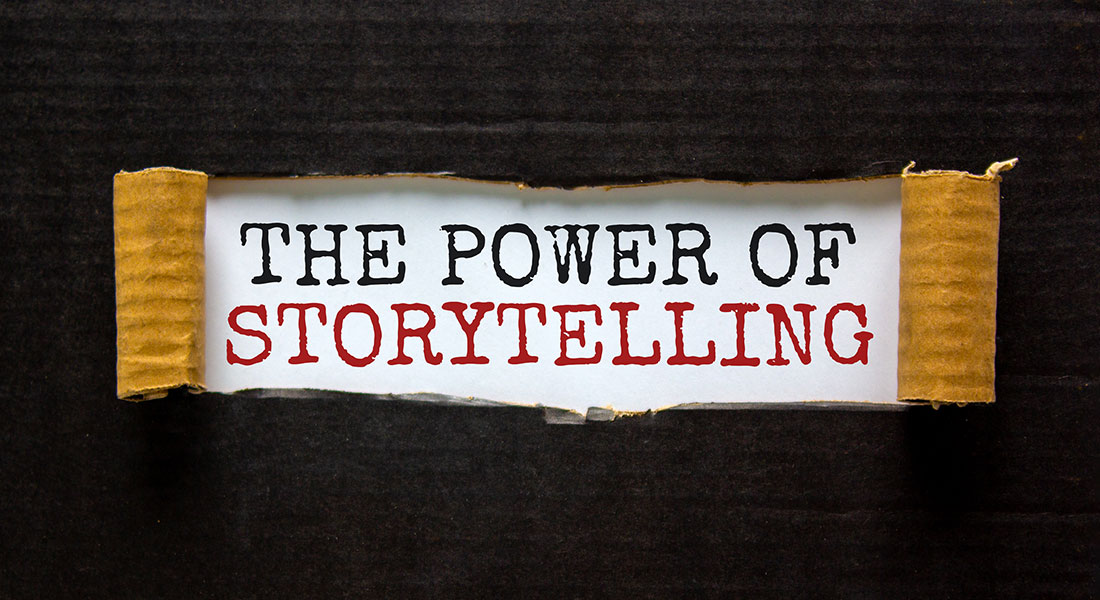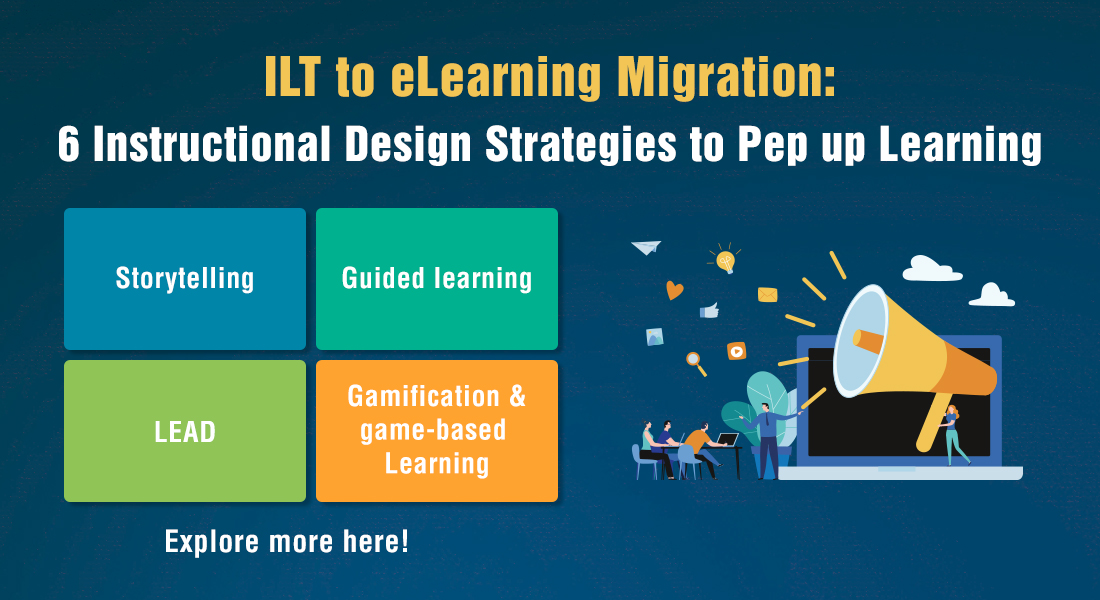Incorporating Storytelling in eLearning – Time to Bid Farewell to Learner Disengagement!

T raining your employees is not always easy. Especially since learners tend to get quite disengaged during training. However, with eLearning, this is not the case. According to the Molly Fletcher Company, eLearning boosts employee engagement by up to 18%. The biggest boon of eLearning is the fact that online courses can incorporate a variety of strategies and formats – from strategies such as microlearning and game-based learning to formats such as videos, and podcasts. These strategies ensure the learner remains engaged throughout the learning journey. One such element that can be incorporated within a course is storytelling. Before we read why use storytelling in eLearning, let us read a story.
How does storytelling make eLearning better?
- Facilitates effective recall
- Facilitates the absorption of necessary knowledge to improve learner performance
- Eradicates learning barriers such as lack of time and uninspiring content
- Fosters a ‘pull’ learning experience
A Story about Everyone’s Favorite – Potato Chips
Did you know how Potato Chips were invented?
In 1853, a customer at the restaurant where George Crum worked as a chef, complained about the fried potato being too thick, soggy, and bland. Well, Crum was not quite pleased, and decided to pay back by playing a trick. Crum sliced the potato very thin and fried it until it could be shattered by a fork’s touch and also sprinkled a lot of salt since the customer complained the fried potatoes were bland.
Crum was sure the customer would have an extremely hard time eating this. But alas! The customer loved it instead, and ended up ordering a second serving. Thus, one of the world’s most favorite snacks was born!
Wondering why I’m talking to you about the invention of potato chips? The point is, you are never going to forget who invented potato chips ever again. Well at least the chances of you remembering who invented Potato chips is much likely than if I had presented it this way:
- Potato Chips were invented by a chef George Crum, accidentally.
Why do you think this is? It is because instead of just giving out the information using bullet points, I told a story instead. Yes, stories indeed have a lot of power.
The Science of Storytelling
Paul J. Zak, Ph.D, the director of the Centre for Neuroeconomics Studies at Claremont Graduate University, conducted an interesting experiment. He gathered a few people and paid them to watch a short movie and collected their blood samples, before the movie.
The movie was about a little boy Ben who is dying of cancer, ignorant of the seriousness, living life joyfully. Ben’s father talks about how hard it is for him to be joyous around Ben, knowing that Ben will not be around after a few months. Eventually Ben’s father gathers the courage to accept the fact and be genuinely happy for Ben’s sake.
After the movie, Zak collected the viewers’ blood samples and realized that 2 chemicals were produced – Cortisol and Oxytocin – after watching it. Cortisol aids individuals in focusing their attention and Oxytocin is related to empathy.
Before they left, Zak gave the viewers a chance to share the money they received, with strangers or seriously ill children. And the individuals who produced a large amount of both Cortisol and Oxytocin ended up being the one’s to donate.
This showed that storytelling indeed had an effect on individuals. In the words of Paul Zak, “This narrative is changing behaviour by changing Brain chemistry.” Storytelling acted as a catalyst in building curiosity, increasing focus, and also inspiring viewers to take proper action – act emphatically in this case.
How Does Storytelling Make eLearning Better?
Yes, stories have an incredible effect on human beings. But what does it have to do with learning? Here is how incorporating stories in eLearning helps eradicate common challenges faced when training employees, as proved by various studies:
70% of the Information is Forgotten Within 24 Hours of Training
Yes. This is true. Also 50% of the information is forgotten within an hour and 90% within a week. Now, how do you think learners can recall whatever they have been trained on if this is the case? Well, incorporating storytelling within your eLearning might be the answer to this. Researchers suggest we are more likely to recall information when our emotions come into play. This is exactly what stories do to us – evoke our emotions.
For example, if you rollout a compliance course on the data privacy laws in your organization and depict a character within a story landing into trouble due to a few careless actions, your learners will begin thinking from the character’s point of view. They will put themselves in the character’s shoe and understand the consequences if they act carelessly, thus leading to effective recall.
Only 25% of Employees Feel Training Improved their Performance
What is the whole purpose of training? To facilitate the absorption of the necessary knowledge to improve the performance of employees at the workplace. Well, what is the point of training if most of your employees feel the training delivered has not improved their performance?
Incorporating storytelling in your eLearning will definitely help improve learner performance. Let us go back to Paul Zak’s experiment. Remember how viewers donated money to strangers and children after watching the story of Ben? Watching the story of Ben inspired viewers to take an action, which they wouldn’t have, if not for the story. This will be the same in eLearning too. Using the storytelling strategy in eLearning will act as a roadmap to learners on how they should be acting in various situations.
One Out Of Three Employees Say ‘Uninspiring Content’ is a Barrier to Learning
How many of you remember those fairytales you read when you were young? How many of you remember the content you learned in middle school? Well, I’m sure most of you would remember fairytales better than middle school content. Why is this so? This is because, most of the content in middle school is just a lot of information presented in the traditional format within a textbook. Whereas fairytales are stories – the content, the structure, and the elements such as the plot, narrative, and the characters are inspiring.
This is what your eLearning courses need too – Extremely inspiring content, structure, and the story elements. Stories are known to instill a sense of curiosity and hook your learners with the learning content. Stories have the capability to take your learners away from their office desks to an altered reality which facilitates new perceptions and being open to new ways of thinking.
For example, most organizations rollout sexual harassment training. But how can you make your learners understand the importance of sexual harassment if they cannot relate to what the victim might go through? This cannot merely be done through bulleted presentations. But with a story, it is child’s play.
A story with a victim and a hero who helps the victim handle the situation fight back will garner good learner attention. Once this story is weaved and incorporated in the beginning of the course, learners can easily relate to the content, thus being motivated to take up the rest of the course, keeping the story in mind.
The #1 Reason Employees Don’t Learn is Because They Don’t Make Time For Learning
Most organizations recognize the value of training and invest in employee training and development. But often the workforce fails to appreciate the learning opportunities available to them. They are often caught up with one task or the other, and don’t perceive learning as priority which in turn makes them believe they cannot make time for training.
But did you ever notice, even individuals who are the busiest will never deny listening to an individual’s story or telling their story – no matter how caught up they are. The point is, people make time for stories even if they are going through a hectic schedule.
Hence, instead of delivering your training in the same old traditional methods, opt for storytelling in eLearning. This will result in pulling your learners toward training, rather than having to push and force them to take up training.
Storytelling can be part of various other strategies in eLearning. Stories can be incorporated in scenario-based learning, game-based learning etc., thus adding to their effectiveness. Even in the all-time-favorite microlearning too, where short stories can be incorporated in bite-sized videos or podcasts, giving you the added advantage of quick consumption of content in a shorter span of time.
Interested to know more on how microlearning can fit into your training framework? Download this free eBook!





